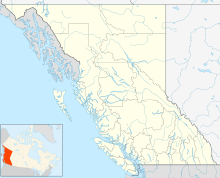Yellowhead Pass
This article needs additional citations for verification. (April 2009) |
| Yellowhead Pass | |
|---|---|
 | |
| Location | Alberta, British Columbia, Canada |
| Coordinates | 52°53′33″N 118°27′50″W / 52.89250°N 118.46389°W |
| Elevation | 1,131 m (3,711 ft) |
| Founder | Canadian Northern Railway Grand Trunk Pacific Railway |
| Original use | Mountain pass |
| Governing body | Parks Canada |
| Yellowhead Pass | |
|---|---|
| Elevation | 1,131 m (3,711 ft)[1] |
| Traversed by | Yellowhead Highway and Canadian National Railway; Via Rail's Canadian, Via's Jasper – Prince Rupert train and the Jasper section of the Rocky Mountaineer using CN tracks |
| Location | Jasper National Park, Alberta / Mount Robson Provincial Park, British Columbia, Canada |
| Range | Canadian Rockies |
| Topo map | NTS 83D16 Jasper |
The Yellowhead Pass is a mountain pass across the Continental Divide of the Americas in the Canadian Rockies. It is on the provincial boundary between the Canadian provinces of Alberta and British Columbia, and lies within Jasper National Park and Mount Robson Provincial Park.

Due to its modest elevation of 1,131 m (3,711 ft) and its gradual approaches, the pass was recommended by Sir Sandford Fleming as a route across the Rocky Mountains for the planned Canadian Pacific Railway. The proposal was rejected in favour of a more direct and southerly route, through the more difficult Kicking Horse Pass, which was opened in 1886. Later the Grand Trunk Pacific and Canadian Northern Railways used the Yellowhead Pass for their main lines, built c. 1910–1913, and the main line of their successor, the Canadian National Railway, still follows the route. Via Rail's premier passenger train, the Canadian; the Jasper – Prince Rupert train; and the Jasper section of the Rocky Mountaineer use the Yellowhead Pass, which is now used also by the Yellowhead Highway.
It is believed that the pass was named for Pierre Bostonais (nicknamed Tête Jaune, French for "yellow head", because of his blond hair), an Iroquois-Métis trapper employed as a guide by the Hudson's Bay Company. Bostonais led one of the first expeditions for the company to what is now the interior of British Columbia through the pass in 1820.
See also
[edit]References
[edit]- ^ Flickr. Yellowhead Pass
External links
[edit]- Mountain passes of Alberta
- Mountain passes of British Columbia
- Great Divide of North America
- Canadian National Railway facilities
- Rail mountain passes of Alberta
- Rail mountain passes of British Columbia
- National Historic Sites in Alberta
- National Historic Sites in British Columbia
- Jasper National Park
- Borders of Alberta
- Borders of British Columbia
- Landforms on the National Historic Sites of Canada register

